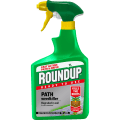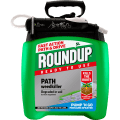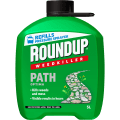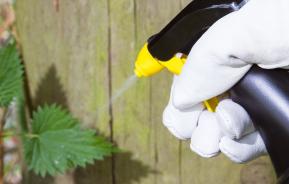Crunchy gravel drives and paths may sound good but weeds can be a year-round problem. Even between paving slabs, perennial weeds and grasses can soon become a nuisance growing in the soil and sand below your path.
Hand weeding is time consuming. Digging ruins the surface and leaves behind pieces of perennial roots that can re-grow and lifting slabs is a mammoth task best avoided. On the other hand, just one weedkiller application gets the job done conveniently and easily.
The best product to use for hard patio or path algae/mould is an algaecidal detergent. Brintons Patio Magic is one of the best path and patio anti-viral and anti-bacterial disinfectants on the market. As a dynamic algaecidal detergent it is perfect for killing mould, algae and mildew on hard surfaces and helping to prevent re-growth for many months. All without the need for manual scrubbing or pressure washing.
Getting the best results

Lots of general-purpose weed killers will kill the weeds and grasses that appear on gravel drives, paths and between the slabs of patios. Some weed killers contain glyphosate, a systemic weedkiller that slowly kills all weed growth including the roots. Glyphosate weedkillers can be used in most areas of the garden except the lawn and the treated areas can be re-seeded or planted as soon as the weedkiller has dried on the treated leaves.
Because seeds can germinate easily immediately after treatment these are not the most effective weed killers for use on gravel drives, paths and patios. What you need is a product that will kill existing weeds and prevent the germination of new seeds.
Check products carefully and look for path weedkillers which mention having long lasting results, when applied correctly some products will keep your paths weed free for around 3 months!
1. Apply weedkiller in spring
You can apply at any time from April to September but the best time is in spring when the existing weeds are growing strongly and before too many new seeds have germinated.
2. Choose a dry day
As many weedkillers go in through the leaves you need to apply on a day when rain is not expected. If rain falls shortly after application a further treatment may be needed
3. Don’t agitate the soil after applying
The systemic effect of the weedkillers may be reduced if you try to remove the top growth before the weed has died back naturally. Allow a few weeks after treatment for the weed root to be killed completely before removing the dead foliage or just leave the weed to decompose naturally.
4. Don’t leave any gaps between plants
Imagine the product applied is in the form of an invisible blanket so any gaps in the treated area may allow weeds to grow through. Also avoid raking over the treated areas as much as possible as this may break up the residual layer and seedlings may pop up.








